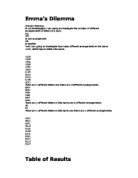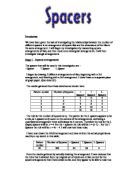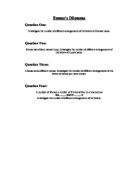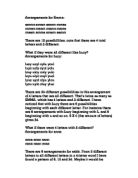Emma's Dilemma.
Emma's Dilemma Emma's Dilemma In my investigation I am going to investigate the number of different arrangements of letters in a word. e.g. Tim Is one arrangement Mit Is another First I am going to investigate how many different arrangements in the name LUCY, which has no letters the same. LUCY LUYC LYCU LYUC LCYU LCUY ULCY UCLY UYLC ULYC UCYL There are 4 different letters and there are 24different arrangements. SAM SMA MSA MAS ASM AMS There are 3 different letters in this name and 6 different arrangements. JO OJ There are 2 different letters in this name and there are 2 different arrangements. UYCL YCUL YUCL YULC YLCU YLUC CYLU CYUL CUYL CULY CLUY Table of Results Number of Letters Number of Different Arrangements 2 2 3 6 4 24 5 20 6 720 7 5040 From the table of results I have found out that a 2 letter word has 2 arrangements, and a 3 letter word has 6. Taking for example a 3 letter word, I have worked out that if we do 3 (the length of the word) x 2 = 6, the number of different arrangements. In a 4 letter word, to work out the amount of different arrangements you can do 4 x 3 x 2 = 24, or you can do 4!, which is called 4 factorial which is the same as 4 x 3 x 2. So, by using factorial (!) I can predict that there will be 40320 different arrangements for an 8 letter word. The formula for this is: n! = a Where n =
The relationships between the number of different spacers in an arrangement of square tiles and the dimensions of the tiles in the same arrangement.
Introduction We have been given the task of investigating the relationships between the number of different spacers in an arrangement of square tiles and the dimensions of the tiles in the same arrangement. I will begin my investigation by researching square arrangements of tiles, and then move onto rectangular arrangements. I will then investigate triangle arrangements. Stage 1 - Square arrangements The spacers that will be used in this investigation are - + Spacer T Spacer L Spacer I began by drawing 5 different arrangements of tiles, beginning with a 1x1 arrangement, and finishing with a 5x5 arrangement. I drew these on a separate piece of graph paper. (See sheet S1). The results gathered from these sketches are shown here: Pattern number Number of Squares + Spacers T Spacers L Spacers 0 0 4 2 4 4 4 3 9 4 8 4 4 6 9 2 4 5 25 6 6 4 The rule for the number of squares is xy. The pattern for the L spacers appears to be a rule, as L spacers only occur on the corners of the arrangements, and being a quadrilateral arrangement there will always be 4 corners. Therefore the rule for the L shaped spacers will be n = 4. For the + spacers the rule will be n = (n-1) . For the T Spacers the rule will be n = 4n - 4. I will now test these rules. I have now drawn the 10x10 arrangement and have written the actual properties as read from my sketch in this
Emma's Dilemma Question One: Investigate the number of different arrangements of the letters
Emma's Dilemma Question One: Investigate the number of different arrangements of the letters of Emma's name. Question Two: Emma has a friend named Lucy, Investigate the number of different arrangements of the letters of Lucy's name. Question Three: Choose some different names. Investigate the number of different arrangements of the letters of names you have chosen. Question Four: A number of X's and a number of Y's are written in a row such as XX.........XXYY.........Y Investigate the number of different arrangements of the letters. Question One: Investigate the number of different arrangements of the letters of EMMA's name. Answer: In order for me to answer this question, I will write down all of the different arrangements for the letters of Emma's name. This will allow me to get the total number of arrangements, which will help me to find a rule in the latter questions in this piece of coursework. Below are all of the different arrangements of the letters of Emma's name: EMMA EMAM EAMM MEMA Total: MEAM 12 MAEM MAME MMEA MMAE AMME AMEM AEMM From my results, I can see that there are 12 different combinations of the letters from Emma's name, if all of the letters are used, and only once. I have set out the letters in an ordered fashion, so that it is easier to find all of the combinations, and to only do a combination once. Therefore, my
Math exam
Storøyungen 4 dager, 29 elever og 4 voksne. Leie av kano, innkjøp av mat: Tilbud 1:Losby besøksgård: Utleiepriser: Kano Lavvo Døgnleie (inntil 24 timer): 350 250 2 døgn (mer enn 24 timer): 500 300 3 døgn: 650 350 4 døgn: 800 400 5 døgn: 950 450 6 døgn: 100 500 Leie ut over dette: Etter avtale. I kanoleien inngår følgende utstyr: 2 stk årer, 2 stk flytevester og kanotralle. Produkt Pr. ukedag Pr. døgn Lørdag Weekend Pr. uke Kano m/ 2 årer og 2 vester kr 300,- kr 400,- kr 450,- kr 600,- kr 1 200,- Beaver Kanotralle kr 100,- kr 100,- kr 150,- kr 150,- kr 250,- Tilbud 2: Beaver kanosenter: 5 kanoer. 2 foreldre kjører kanoene opp med henger. Hvor mye kostet bensinen de bruker på å kjøre? Mat: Frokost og kvelds--> Brød med div. pålegg. Juice, appelsin epple. Middag dag 1: Kjøttdeig og ris. 4 stykker pr. gruppe, vi deler ut maten. Middag dag 2: spagetti på boks. 2 bokser pr. gruppe? Middag dag 3: pølse og lompe på bål, maks 3 pølser hver. Drikke: Appelsin og eplejuice, Husk: Mer verdig avgift!! Sykkeltur: Fra Skedsmokorset til Storøyungen. På kart med målestokk 1:1000 000 2,4cm til Storøyungen. 2,4 cm x 1000 000 = 2 400 000 cm = 24 000 m = 24 km = 2,4 mil. 2 grupper: Raske --> fart på 17 km/t ( 9 stykker ) Sakte --> 12 km/t (20 stykker) Funksjons diagram: Rask: 24 km / 17 km/t = 1,41. Gjøre om
Investigating the arrangements of letters in words.
Introduction I am doing an investigation into words and the number of ways the words can be written. I will find formulae and work out the number of combinations for the words. Originally the task was to find combinations for the word MATT, but I decided to look at sequences of letters from the alphabet, which makes it easier to monitor and control because letters can be written in sequence eg. A-B-C. I will start by looking at words with no letters the same because this is the simplest to work with. I will find a formula for that, beginning with words that are 1 letter long and carrying on to letters that are 5 letters long so I have a wide range of data to form a formula out of and test it . E.g. ABCD Next I will look at words that have two letters the same e.g. AABC because the name Matt has 2 T's in it. I will be using the same method as before but starting with 2 letter words and expanding the amount of letters to 5 or 6 letter words so again I will have a significantly large range of data to for a formula from. By doing this I am expanding the investigation and gaining more knowledge of the pattern of formulae. Throughout the investigation I will use 3 algebraic expressions. n =number of letters in total within the word. c= number of combinations found in total n!=n factorial Also I will be using simplified diagrams for large numbers. eg 4 letters
Compare and contrast the fictional letters in 'Birdsong' with the real letters written to Vera Brittain by Edward Brittain and Roland Leighton. Which do you find more moving and powerful and why?
Compare and contrast the fictional letters in 'Birdsong' with the real letters written to Vera Brittain by Edward Brittain and Roland Leighton. Which do you find more moving and powerful and why? The letters sent in the war were one of the most important ways of communicating with loved ones. A stereotypical view would be that letters would seem quite heart-felt and filled with detailed descriptions of the reality thrown at the soldiers. However in reality the emotion doesn't come across frequently. In 'Birdsong,' Faulks picks out key elements to format emotive letters. The tone of each letter varies, but a general positive attitude comes across through the letters, with the exception of 'Stephen's' letter. The tone in 'E.Brittain's' and 'Leighton's' letters did not make much of an impression; it was a detailed account of their normality in the war. Their viewpoint of the war did not seem to emerge. Both letters consists of war jargon and formal language which prevents their true feelings to be empathised with, making their letters less moving than 'Faulk's' fictional letters. In contrast with the reality, the readers can vaguely pick up on the characters' viewpoint in 'Birdsong' through the language and tone making the letters to appear more powerful. 'Faulks' has intentionally written the character's letters before the Battle of the Somme. In 'Weir's' letter the first
Emma's Dillemma
Arrangements For Emma: Amma emam eamm mmae Mmea meam mema mame Maem amme amem aemm There are 12 possibilities for the name Emma but if you note there are 4 total letters and 3 different. Arrangements for Lucy, note which are all different letters: Lucy ucyl cylu ycul Luyc ucly cyul yclu Lcuy ulcy culy yulc Lcyu ulyc cuyl yucl Lyuc uycl clyu ylcu Lycu uylc cluy yluc There are 24 different possibilities in this arrangement of 4 letters all different. Double the amount as before with Emma's name, which has 4 letters and 3 different. I have noticed that Lucy there are 6 possibilities beginning with each different letter. For example there are 6 arrangements with Lucy beginning with L, and 6 beginning with u and so on. 6*4 ( the amount of letters) gives 24. What if there were 4 letters with 2 different? Arrangements for aabb: Aabb abab baab Abba baba bbaa There are 6 arrangements for aabb. From 2 different letters to all different in a 4 letter word. I have found a pattern of 6, 12 and 24. As I have found that there were 24 arrangements for a 4 letter word with all different letters and that there were 6 ways beginning with on of the letter I predict that there will be 120 arrangements for lucyq, 24 for a, 24 for b, 24 for c; ect. 120 divided by 6 ( number of letters) equals 24. Previously in the 4 letter word, 24 divided by 4 equals 6, the number of
Emma's Dillemma - Rearranging Emma's Name in different permutations
Arrangements for Emma: emma emam eamm mmae mmea meam mema mame maem amme amem aemm There are 12 possibilities; note that there are 4 total letters and 3 different. What if they were all different like Lucy? Arrangements for Lucy: lucy ucyl cylu ycul luyc ucly cyul yclu lcuy ulcy culy yulc lcyu ulyc cuyl yucl lyuc uycl clyu ylcu lycu uylc cluy yluc There are 24 different possibilities in this arrangement of 4 letters that are all different. That's twice as many as EMMA, which has 4 letters and 3 different. I have noticed that with Lucy there are 6 possibilities beginning with each different letter. For instance there are 6 arrangements with Lucy beginning with L, and 6 beginning with u and so on. 6 X 4 (the amount of letters) gives 24. What if there were 4 letters with 2 different? Arrangements for anna: anna anan aann nana naan nnaa There are 6 arrangements for aabb. From 2 different letters to all different letters in a 4-letter word I have found a pattern of 6, 12 and 24. Maybe it would be easier to see what is happening if I used larger words. What if there was a five-letter word? How many different arrangements would there be for that? As I have found that there were 24 arrangements for a 4 letter word with all different letters and that there were 6 combinations beginning with each of the letters in the word I predict that there will be 120
permutations & combinations
Plan In this coursework, I will be dealing with an unfamiliar task. I have to get around different words and find alternative variations for them. I must try to get different letter words, so that I can apply my knowledge and understanding to a broader scope. I have to use a range of mathematical formulas and use different mathematical techniques to explain this formula and how I got there. In the end I have to give all my mathematical formulas and give a conclusion on what I have discovered. I can start off by finding out alternatives for some simple four-letter words. LUCY- Different arrangements for this word: . UCLY 2. UCYL 3. UYLC 4. UYCL 5. ULYC 6. ULCY 7. CYUL 8. CYLU 9. CULY 0. CULY 1. CLUY 2. CLYU 3. YCUL 4. YLCU 5. YULC 6. YCLU 7. YUCL 8. YLUC 9. LUCY 20. LYCU 21. LCUY 22. LCYU 23. LYUC 24. LUYC These were 24 different arrangements for a four-letter word, with no similar letters. By this word we can confirm that a four-letter with no repetitive letters will have 24 variations. KATE . KEAT 2. KETA 3. KTEA 4. KATE 5. KTAE 6. KAET 7. ATEK 8. ATKE 9. AKTE 0. AKET 1. AEKT 2. AETK 3. TEAK 4. TEKA 5. TKEA 6. TKAE 7. TAKE 8. TAEK 9. ETAK 20. ETKA 21. EKTA 22. EKAT 23. EAKT 24. EATK A three-letter word will have 6 variations. This can be proved by the following word TOM . TOM 2. TMO 3. OMT 4. OTM 5. MOT 6. MTO
I have been given a problem entitled 'Emma's Dilemma' and I was given the following information: 'Emma and Lucy are playing with arrangements of their names
Emma's Dilemma I have been given a problem entitled 'Emma's Dilemma' and I was given the following information: 'Emma and Lucy are playing with arrangements of their names. One arrangement of Lucy is: L U C Y A different arrangement is: Y L C U Part 1: Investigate the number of different arrangements of the letters of Lucy's name. Part 2: Investigate the number of different arrangements of the letters of Emma's name. Part 3: Investigate the number of different arrangements of various groups of letters.' So basically I had to investigate how the number of permutations for words alters depending on the letters that make up that word, starting off with looking at Lucy and then comparing it to Emma, and after that extending it to look at any word with various letters. I aim to produce a formula to produce the number of permutations. Part 1- Investigating Lucy: The name Lucy comprises of four different letters that we can quite simply rearrange to produce a number of arrangements. Firstly I worked out the number of arrangements that I could get from the letters of 'Lucy': LUCY LUYC LYUC LYCU LCUY LCYU ULCY ULYC UCLY UCYL UYLC UYCL CLUY CLYU CYLU CYUL CUYL YLUC YLCU YUCL YULC YCUL YCLU I found that the name Lucy can be arranged 24 different times as shown above. This would work for any four letter word as long as all the letters were different.











